Expedition 12 back from Antarctica, safe in Dunedin
On Sunday 24 November 2019, Otago Space Physics Antarctic Expedition 12 returned to Dunedin. This year had a few mechanical problems – originally scheduled to leave Scott Base on Wednesday 20 November, the flight finally happened late on Saturday 23 November, arriving in Christchurch at 3am the next day. Another successful trip to Antarctica [25 November 2019].
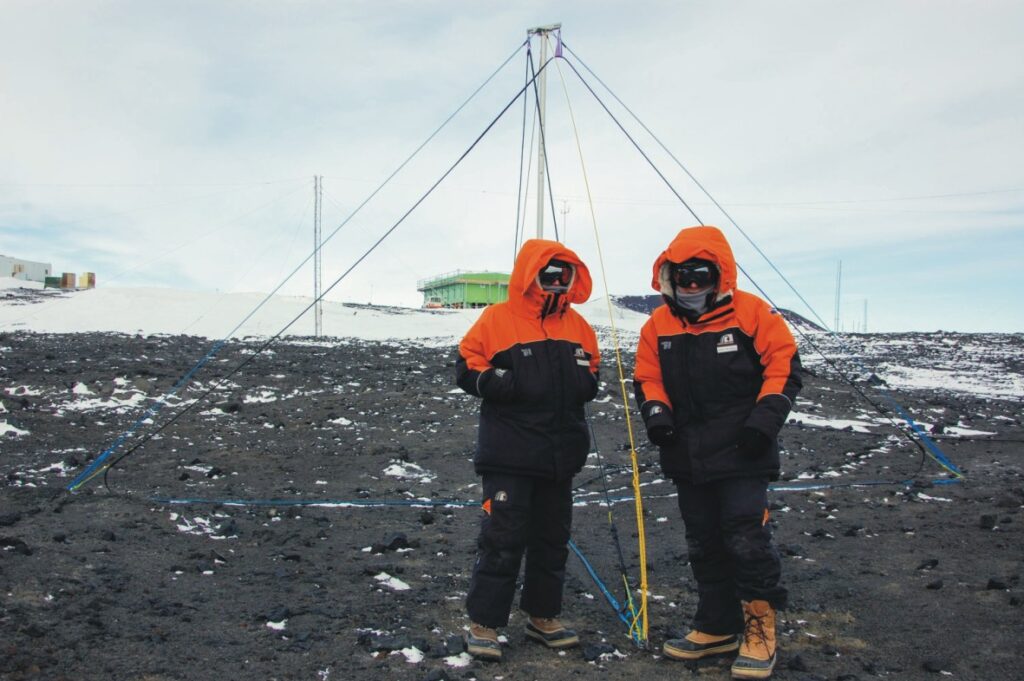
Emily and James, on the ice!
Otago Space Physics group, visiting the world this November
In late November a lot of the Otago Space Physics group were not in Dunedin. Dr James Brundell and MSc student Emily Gordon left Christchurch for Antarctica on Wednesday 13 November 2019. A few days earlier Dr. Annika Seppälä had left New Zealand to attend the SCOSTEP VarSITI (Variability of the Sun and Its Terrestrial Impact) program summarising workshop, held in Nagoya, Japan. And then on Friday 15 November 2019, Craig Rodger and PhD student Daniel Mac Manus left Dunedin to head to Belgium – they both attended the 16th European Space Weather Week which was in Liege [22 November 2019]. And the travel does not end yet – Annika, Emily, and Jono will be heading to the AGU Fall Meeting at the start of December.
Expedition 12 heading to the Antarctic
On Wednesday 13 November the Otago Space Physics Group’s 12th annual Antarctic expedition departed Christchurch for Antarctica. Following our tradition, James sent us a picture from the plane shortly before the doors closed and they headed down to the ice. Once again, Expedition 12 flew on a USAF C-17 transport. Expedition 12 is made up of a two person team, Dr James Brundell and MSc student Emily Gordon. This is Emily’s first time heading to Antarctica, but the 11th visit for James Brundell. In 2019 the team struck mechanical delays, spending 2 extra nights in Christchurch before flying south.
The logistics support, comprising air transport, accommodation, and all other on-ice support is provided through Antarctica New Zealand Event K060. James and Emily will be based at Scott Base, and will work around the base and also up at Arrival Heights. Expedition 12 will gather high resolution data, undertake calibrations, and go hunting for some problematic radio interference which is affecting our measurements in the Arrival Heights “radio quiet zone” which appeared earlier this year [13 November 2019].
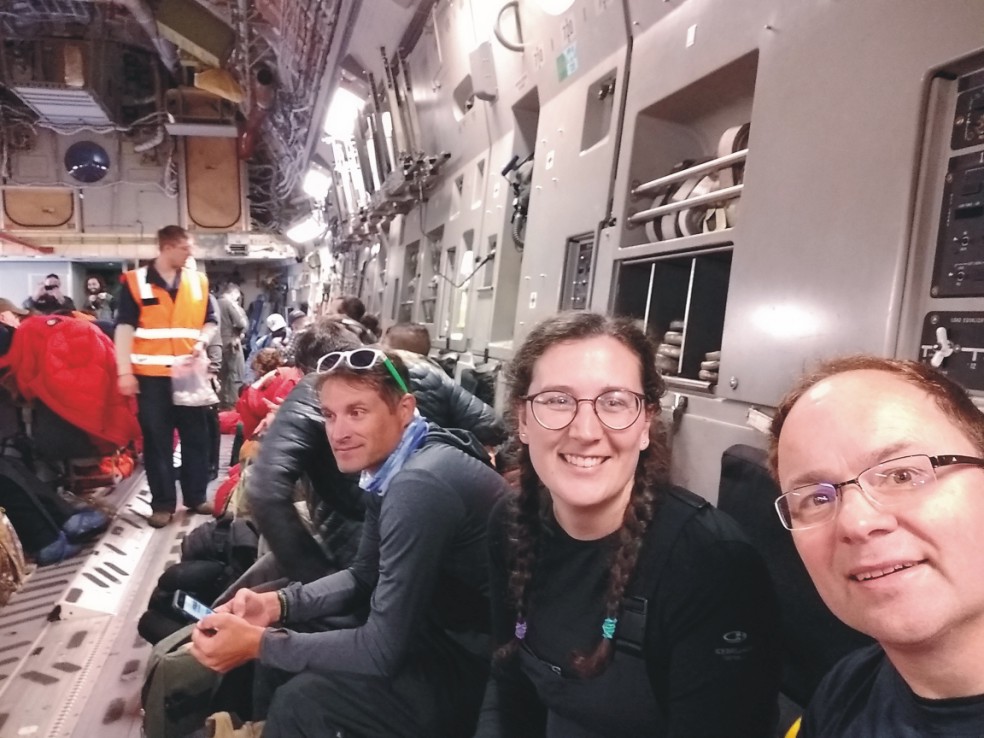
Emily and James, ready to go!
Michael Dalzell selected as 2019 Young Engineer of the Year by the Electricity Engineers’ Association
Last night our collaborator Mike Dalzell was awarded the 2019 Young Engineer of the Year by the Electricity Engineers’ Association (EEA). Mike graduated from the University of Canterbury in 2008 and has spent his professional career with Transpower, where he is now the HVDC & Power Electronics Engineering Team Leader. The award is given to an engineer under the age of 35.
For the last 4 years Mike has been working with us on our MBIE-funded Geomagnetically Induced Current/Space Weather project, and Prof. Craig Rodger of the Space Physics group supported Mike’s nomination for this award. Craig noted the invaluable role which Mike had played in the research saying “[In] meetings between physics-based scientists and the engineering-focused teams, Mike is providing translation between the groups. My UK based collaborators have noted how rare this ability is to speak between the communities”. As the winner of the Young Engineer of the Year, Mike will represent New Zealand at the IEC Young Professionals Programme in Shanghai in October. He is already New Zealand’s representative on the Cigre B4 (HVDC & Power Electronics) Study Committee, Transpower’s representative on the New Zealand Committee for the Co-ordination of Power and Telecommunications Systems [26 June 2019].
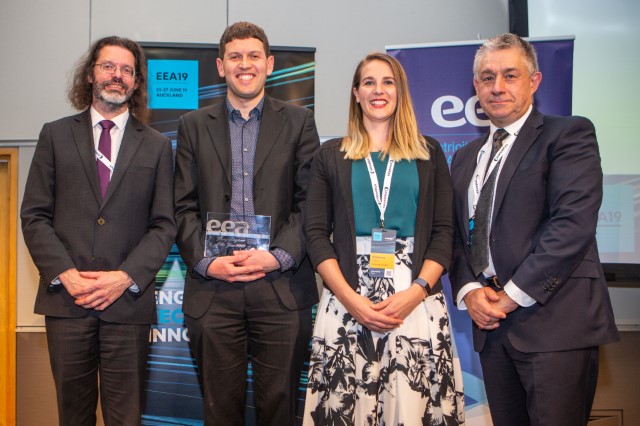
Mike with award (2nd from left)
Wellington Visit
In mid-May Space Physics PhD student Daniel Mac Manus and Craig headed to Wellington to talk to Transpower New Zealand Ltd. We spoke with the Transpower staff about the hazard posed by extreme geomagnetic storms to the New Zealand power grid, and discussed possible mitigation approaches. Craig and Daniel then headed up to the Haywards substation in Lower Hutt, where they were toured around the site. Haywards is the northern-most point of the HVDC link between the South and North Island’s (colloquially known as the “Cook Strait Cable” to most New Zealanders). It is also one of the largest substations in the country. Daniel stayed in Wellington for the rest of that week to develop a better DC electrical representation of the North Island power grid [19 May 2019].
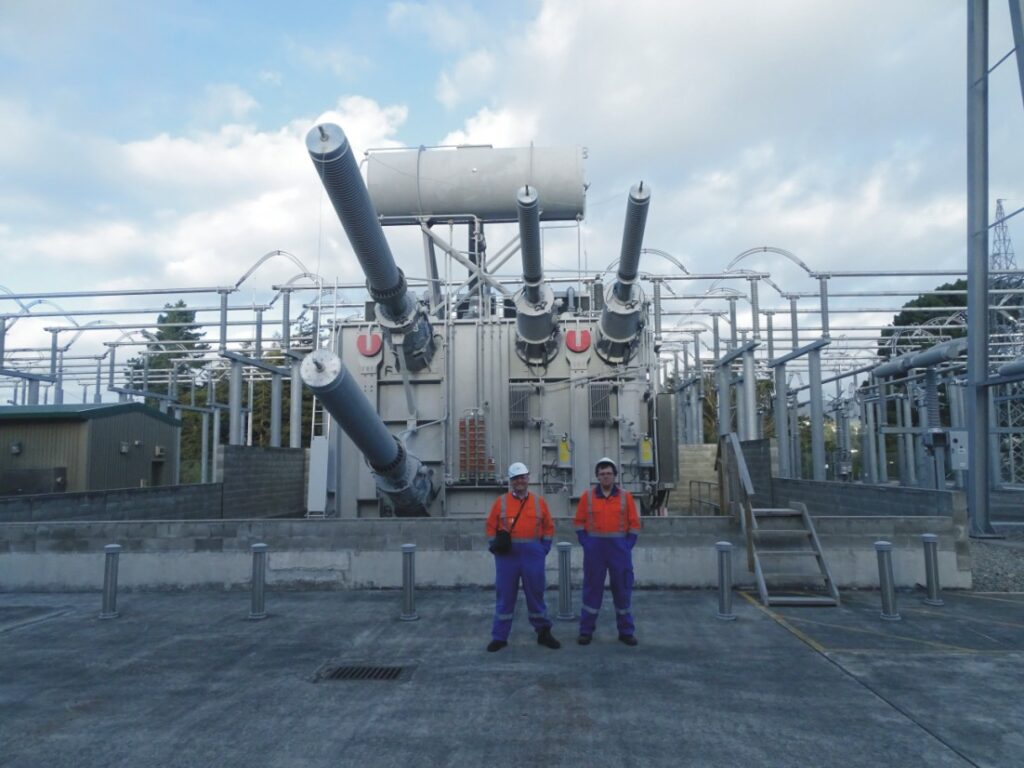
Emma successfully completes PhD oral examination, is awarded “exceptional thesis”
Today Emma Douma had the oral examination for her PhD. This was a success – the examiners agreed that her thesis should be accepted after minor corrections. This photo was taken immediately after the end of the exam, and shows Emma with her supervisor Craig Rodger, and the internal examiner Prof. Pat Langhorne. A PhD is a marathon, but Emma is now very close to the finish line! And just in time for Christmas [18 December 2018]. UPDATE: In late-January 2019 we learnt that the completed examination process had declared Emma’s thesis to be of exceptional quality.This means her work is to be placed on the 2018 list of Science Division Exceptional PhD Theses. According to the University of Otago Science Division website: “A thesis is of exceptional quality when all three examiners of a candidate’s thesis agree that the thesis is of an exceptional standard in every respect – research content, originality, quality of expression and accuracy of presentation – and is amongst the top 10% of theses examined.” Well done Emma! [21 January 2019]
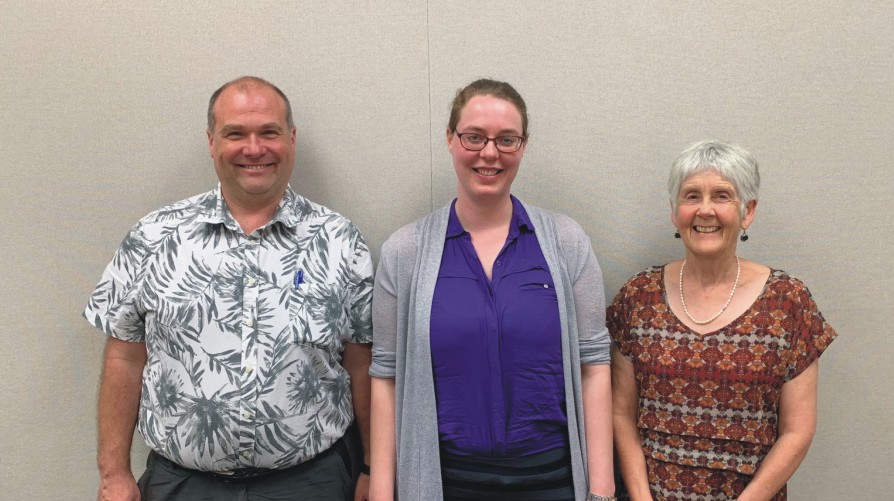
Expedition 11 home safe from Antarctica!
Early this morning Otago Space Physics Group’s 11th annual Antarctic expedition returned to Christchurch from Antarctica. They had originally been scheduled to return last Wednesday, but there was a problem with the plane. A new part had to be flown to Christchurch and a repair made – Antarctic travel is never easy. In the end they left Antarctica every early in the morning of Friday 23 November, and landed in Christchurch at about 630am. They only just had time for immigration and biosecurity clearance, handing back the clothing to Antarctica New Zealand, before boarding the 830am flight to Dunedin. Welcome home James and Myles! Another productive and successful trip to the ice is over [22 November 2018].
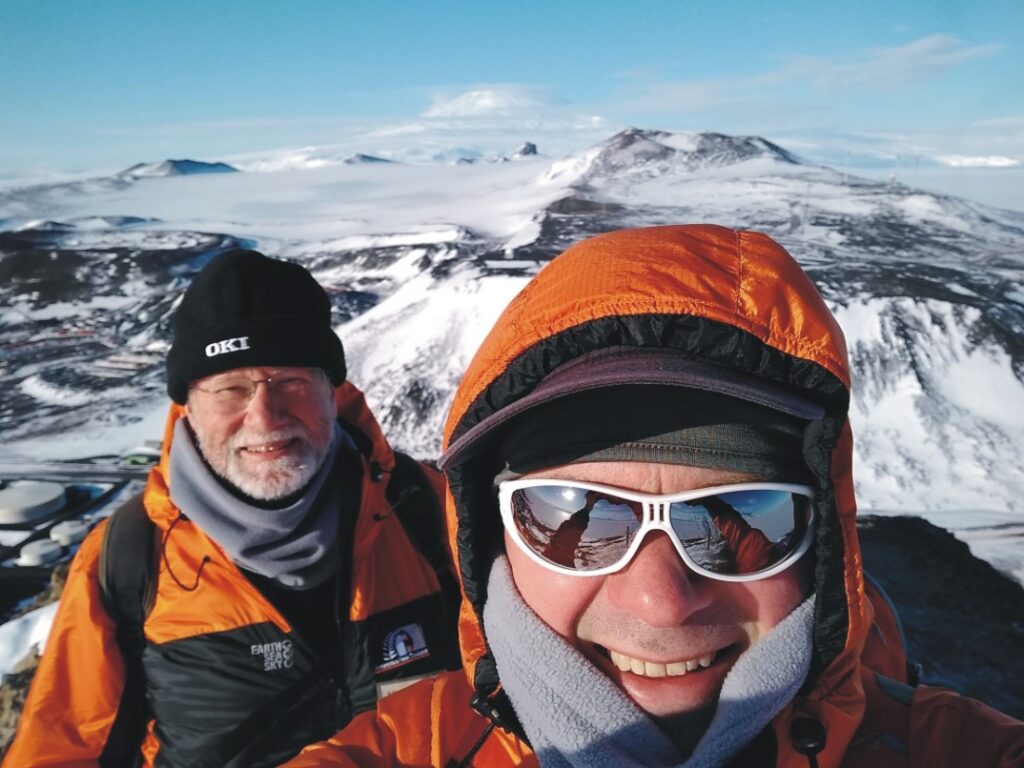
Myles Thayer (left) and James Brundell on the summit of Observation Hill, Ross Island, Antarctica. Mt Erebus is visible in the distance and the Memorial Cross can be made out too in the reflection of James’ sunglasses!
Bringing Space Weather to the people of New Zealand
Craig Rodger returned to Dunedin on Monday 12 November, having flown back from Europe where he was attending the European Space Weather Week conference in Leuven. The next morning he hopped on a plane in Dunedin airport to start the travel associated with a series of Public Lectures. Craig travelled to Auckland, Christchurch and Wellington (yes, in that order) to give open lectures on Space Weather. The talks were given by a team of three – Craig on the basic ideas behind Space Physics and the physical impacts on technology, Malcolm Ingham (Victoria University of Wellington) on possible impacts on pipelines, and Ian Griffin (Otago Museum) on auroral viewing and his obsession with chasing the southern lights. The networking discussions after each talk were great opportunities for the people present to ask questions and chat. The Wellington event clearly included a lot of participants from many different government departments who were keen to learn more. The after match discussions were fascinating! During our travels we also visted the US Consulate in Auckland and one of the Transpower National Grid Operating Centres in Christchurch.
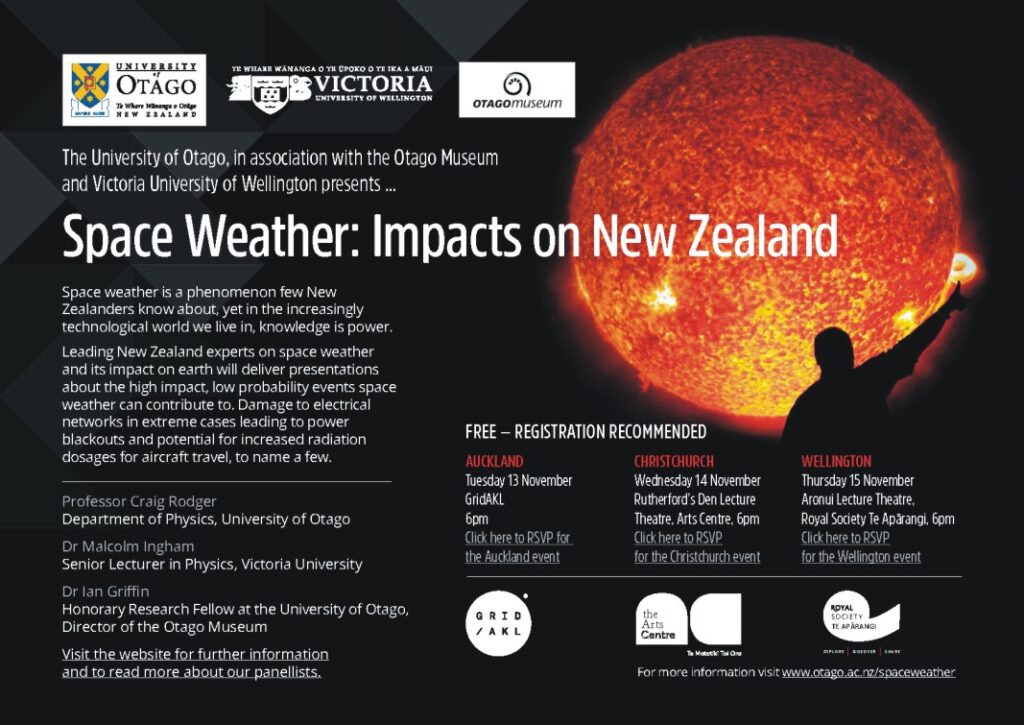
The invite for the public talks. That is Craig in front of the Sun.
The public talks triggered a small series of media interest. First of all, the Otago Daily Times wrote an article entitled (Focus on ‘Space Weather’) on 14 Nov 2018. This was followed up by a recorded interview played in the Weekend Variety Wireless show on 17 Nov 2018 – that interview was a bit of a struggle as it was recorded a few hours after Craig had landed in Dunedin coming back from Europe! Then today Craig was interviewed live by Kathryn Ryan for the Nine to Noon show of Radio New Zealand. The web team at Radio New Zealand produced a very fine summary article from the interview. But what a week it has been. [20 November 2018].
Expedition 11 heading to the Antarctic
This morning the Otago Space Physics Group’s 11th annual Antarctic expedition departed Christchurch for Antarctica. As has become a tradition, we received a picture from the team not long before the USAF C-17 transport left Christchurch. Space Physics Expedition Eleven is made up of Dr James Brundell and Myles Thayer. This is Myles’s first trip to the ice, and James’ tenth. This year there were no mechanical or weather delays, and the plane departed on the day which was planned many months ago!
The logistics support, comprising air transport, accommodation, and all other on-ice support is provided through Antarctica New Zealand Event K060. James and Myles will be based at Scott Base, and will work around the base and also up at Arrival Heights. Expedition 11 will gather high resolution data, undertake calibrations, and possibly replace the top-piece of our electric field antenna outside Scott Base. [12 November 2018].
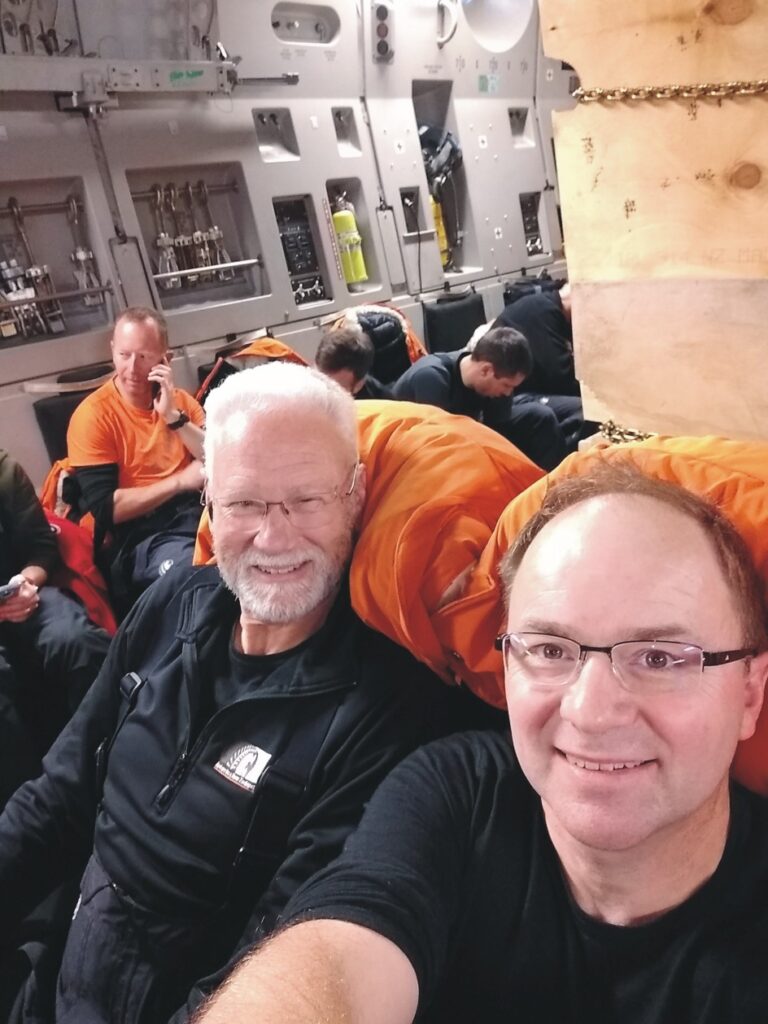
Expedition 11, ready to go South!!
Craig goes to Rocket Lab facility in Auckland
At the end of August Craig appeared on TVNZ’s Seven Sharp programme, talking about lightning. This seems to have been well received. In fact, it produced a new invite to join TVNZ reporter Michael Holland on a tour of the new Rocket Lab rocket development and production facility in Auckland. The new facility was opened on Friday 12 October 2018, by the Prime Minister and William Shatner. Alas, Craig was not invited to that! However, the day beforehand TVNZ and Craig had a behind the scenes tour of the facility by Rocket Lab Chief Executive Peter Beck. They spent an hour looking around the factory with Peter, and amost two hours extra without him. While Rocket Lab had only been in the new building for ~3 weeks, they already had 6 rockets being built on the factory floor, and an operational Mission Control Centre in the attached building. The Rutherford engines are built to Peter’s design in the Rocket Lab factory in the USA, but the new Auckland factory produces the rest of the rocket – at least the ones which will be launched at Rocket Lab’s LC1 on the Mahia Peninsula.
During the visit Peter Beck told Craig how Rocket Lab’s launch vehicle is designed to limit the produce of new space junk; while most of the space junk in orbit is actually rocket parts and not dead satellites, Rocket Lab is not going to add to this problem. Like many launch vehicles the first stage of the Electron Rocket is discarded into the atmosphere. But Rocket Lab ensures the second stage and kick stage do not go into stable orbits, and will quickly burn up into the atmosphere. Rocket Lab is in a huge growth period right now, hiring 5 to 10 people a week both in New Zealand the USA – this is necessary as they work towards the planned “once a week” launch plan by 2020.
This visit was a wonderful chance for the head of Otago’s Space Physics group to meet Peter, an internationally successful rocket engineer and respected entrepreneur. As Peter Beck is originally from the South Island, and started work in Dunedin, Craig hopes he will come down and visit our Otago students soon. The Seven Sharp episode was broadcast on Friday 12 October 2018, shortly after the formal opening.
International CHAMOS meeting in Dunedin
In early October 2018 the Otago Space Physics group hosted the international CHAMOS workshop in Dunedin. CHAMOS stands for Chemical Aeronomy in the Mesosphere and Ozone in the Stratosphere, and is a group of researchers who have gathered for many years to talk about the impact of space on the upper atmosphere. Previous CHAMOS workshops have occurred in Finland, but this year CHAMOS members travelled to the southern hemisphere for the first time.Particpiants came from 4 countries (New Zealand, Finaland, the UK, and Korea) and 5 institutions (University of Otago, Sodankylä Geophysical Observatory, Helsinki University, British Antarctic Survey, and Korea Polar Research Institute). The workshop ran from 8 to 12 October 2018.
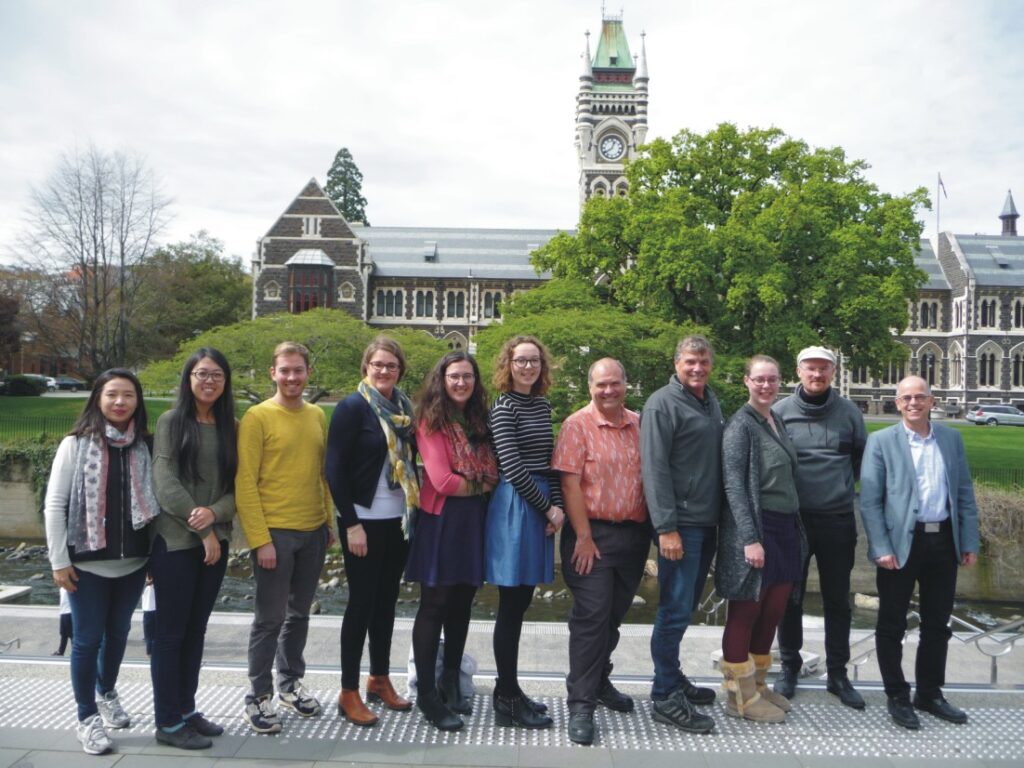
Present from left to right: Ji-Hee Lee (Korea Polar Research Institute), Jia Jia (Sodankylä Geophysical Observatory), Maxime Grandin (Univ. Helsinki), Annika Seppälä (Univ. Otago), Emily Gordon (Univ. Otago), Harriet George (Univ. Otago), Craig Rodger (Univ. Otago), Mark Clilverd (British Antarctic Survey), Emma Douma (Univ. Otago), Antti Kero (Sodankylä Geophysical Observatory), and Esa Turunen (Sodankylä Geophysical Observatory).
Space Weather MBIE Closedown meeting
How 3 years have sped by. At the end of September 2018 our 3-year MBIE funded Space Weather research project came to an end. The project was entitled Solar Tsunamis: Mitigating Emerging Risks to New Zealand’s Electrical Network. In the last 2 days of September 2018 we hosted a workshop to report on the results of our research. Highlights were 7 research papers, two editors highlights, a cover image and 5 presentations to Transpower staff about the research. We also launched an aurora alerting service for the lower South Island. Participants in the workshop included people from Transpower, Otago University, Victoria University of Wellington, British Geological Survey, British Antarctic Survey, and GNS Science [27-28 September 2018]. The close down workshop also brought back 3 of our UK collaborators to Dunedin!
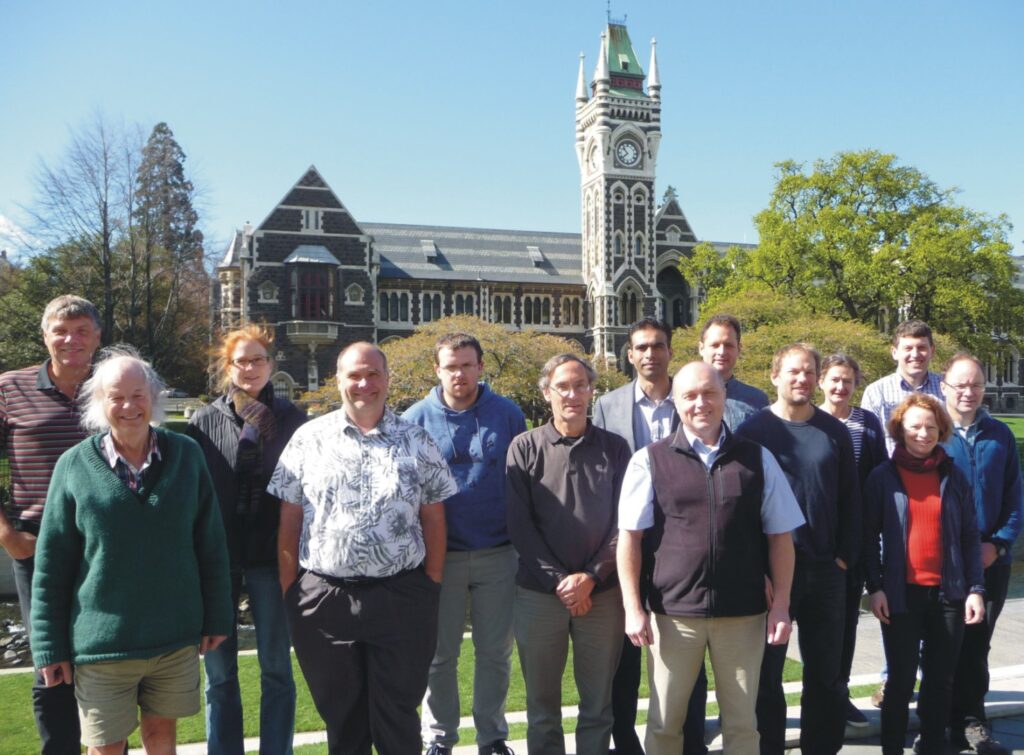
In the image, from left to right: Mark Clilverd (British Antarctic Survey), Neil Thomson (OtagoU), Wiebke Heise (GNS Science), Craig Rodger (OtagoU), Daniel Mac Manus (OtagoU), Malcolm Ingham (VUW), Kamran Mukhtar (VUW), Alan Thomson (British Geological Survey), Tim Divett (OtagoU), Ted Bertrand (GNS Science), Ellen Clarke (British Geological Survey), Tanja Peterson (GNS Science), Mike Dalzell (Transpower), James Brundell (OtagoU)
Craig in the News
Wednesday 29 August was a big day for news coverage of the Space Physics research group. Early in the day the US Embassy & Consulate in New Zealand posted two articles about Craig Rodger‘s research. These appeared online as Space Weather and Kiwis at NASA: More exciting areas of U.S.-NZ scientific cooperation and Lightning Storms! Volcanoes! Even more exciting areas of U.S.-NZ scientific cooperation. Completely independently journalists from TVNZ’s Seven Sharp programme were in touch with Craig about lightning, and ended up flying a TV crew down from Auckland to shoot footage in the Physics Department. The film crew arrived at 315pm, left at 410pm, and a piece appeared in that nights show. TVNZ has made the clip available online in a piece entitled “There are thousands of lightning strikes in NZ each years – so who’s keeping count?” [30 August 2018].
Emma Submits her PhD Thesis
On Friday 24 August 2018 Space Physics PhD student Emma Douma submitted her PhD thesis at the front desk of the Graduate Research School. Her thesis is entitled “Relativistic Electron Microbursts: Properties and Possible Plasma Wave Drivers“, and combines satellite and ground-based data. As is clear from the title, it is focused on relativistic electron microbursts, improving our understanding of their properties and drivers. Emma’s work has led to three papers (so far). Well done Emma! [24 August 2018].
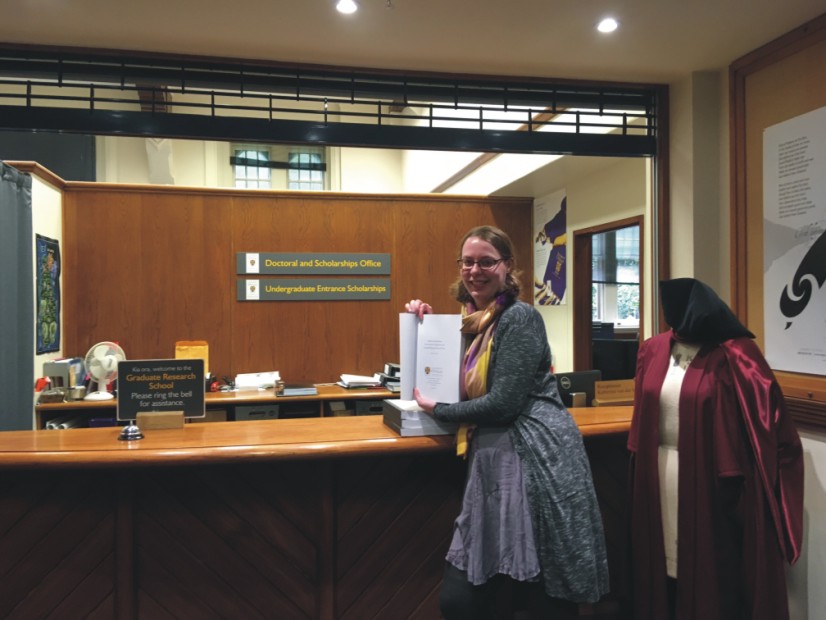
Emma at the front desk of the Graduate Research School, handing her thesis in for examination!
Emma wins poster prize
Space Physics PhD student Emma Douma has been awarded first prize at the recent University of Otago Postgraduate Research Poster Competition. The poster she submitted to the competition was entitled “Space weather impacts in Antarctica“, and was created for last years Antarctic Science Conference (held in Dunedin). This was a very nice surprise for the group. Congratulations Emma! [8 August 2018].
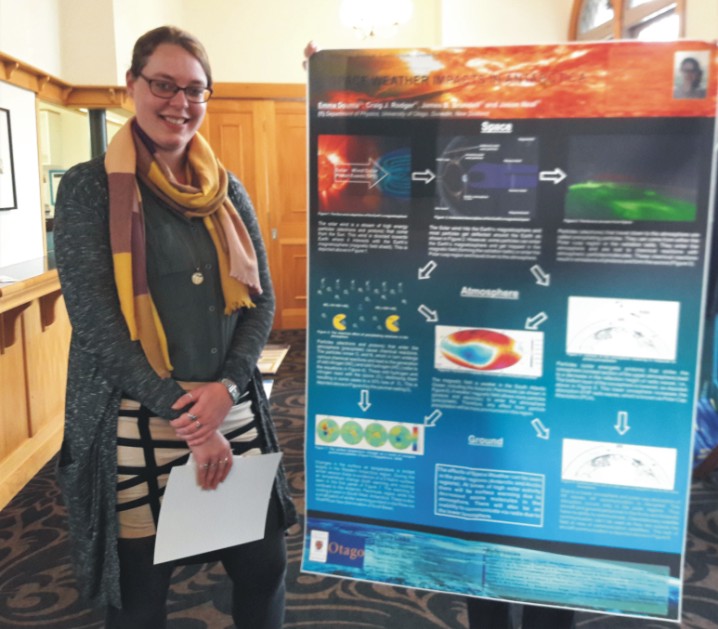
Emma standing beside her prize winning poster!
GIC work declared Editor’s Highlight – Twice!
Our MBIE funded project on Geomagnetically Induced Currents (GIC) is rapidly coming to an end (the project formally ends at the end of September). In the last few months we have had two examples of good news associated with the project – two different research papers produced due to the MBIE project have been selected as Editors’ Highlights of the American Geophysical Union journal Space Weather [20 July 2018].
The first of these papers was led by Malcolm Ingham (Victoria University of Wellington), exploiting the long Transpower New Zealand GIC database to produce a model of current production – and then estimate the likely peak crrents for an extreme Carrington-class storm (Ingham, M., Rodger, C. J., Divett, T., Dalzell, M., & Petersen, T. [2017]. Assessment of GIC based on transfer function analysis. Space Weather, 15. https://doi.org/10.1002/2017SW001707). The paper highlight provides more description.
The second of these papers was led by Mark Clilverd (British Antarctic Survey), focusing on the recent very large geomagnetic storm on 7-8 September 2017. Due to the large GIC occurring at Transpower transformers in Dunedin, significant harmonic distortion was produced. This is monitored by Transpower at 10 minute resolution – however, Mark used the wideband VLF receiver we deployed as part of the MBIE project to investigate the harmonic production at higher time and frequency resolution (Clilverd, M. A., Rodger, C. J., Brundell, J. B., Dalzell, M., Martin, I., Mac Manus, D. H., et al. (2018). Long‐lasting geomagnetically induced currents and harmonic distortion observed in New Zealand during the 7–8 September 2017 disturbed period. Space Weather, 16. https://doi.org/10.1029/2018SW001822). The editor highlighted the innovative and powerful nature of the use of the VLF measurements to provide Space Weather context.
Emma and Craig in North America
In early July Craig and Emma left the New Zealand winter and flew to North America. They initially headed to Toronto, to attend the SCOSTEP 14th Quadrennial Solar-Terrestrial Physics Symposium. The next weekend they flew to LA to join the 42nd Scientific Assembly of the Committee on Space Research (COSPAR) in Pasadena. Craig and Emma both presented at both meetings.
During the first conference, someone decided to tweet and image of Craig, mid-presentation [16 July 2018].
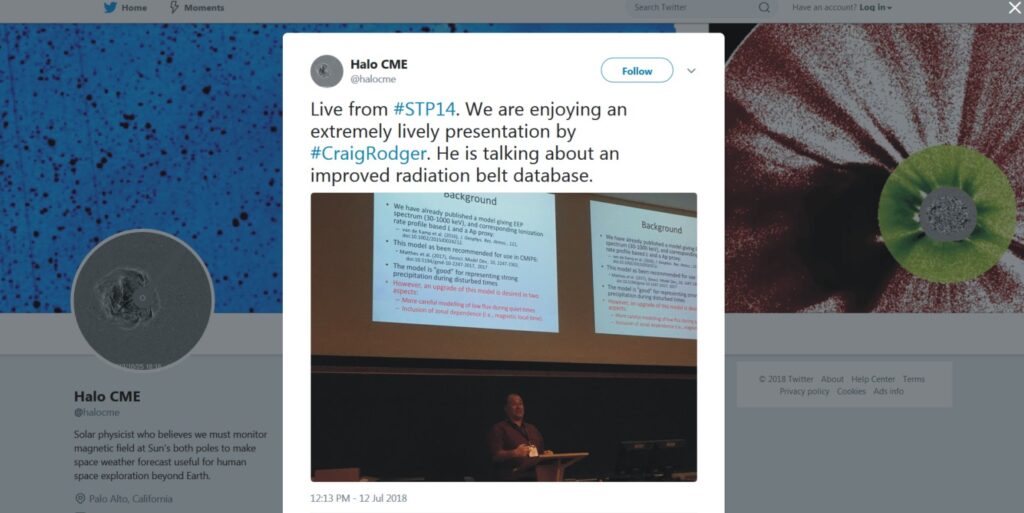
Tweet apparently sent midway through Craig’s STP14 presentation.
At the second conference, Alexa Halford (now at NASA) tweeted an images and some comments during his Space Weather presentation as well [16 July 2018].
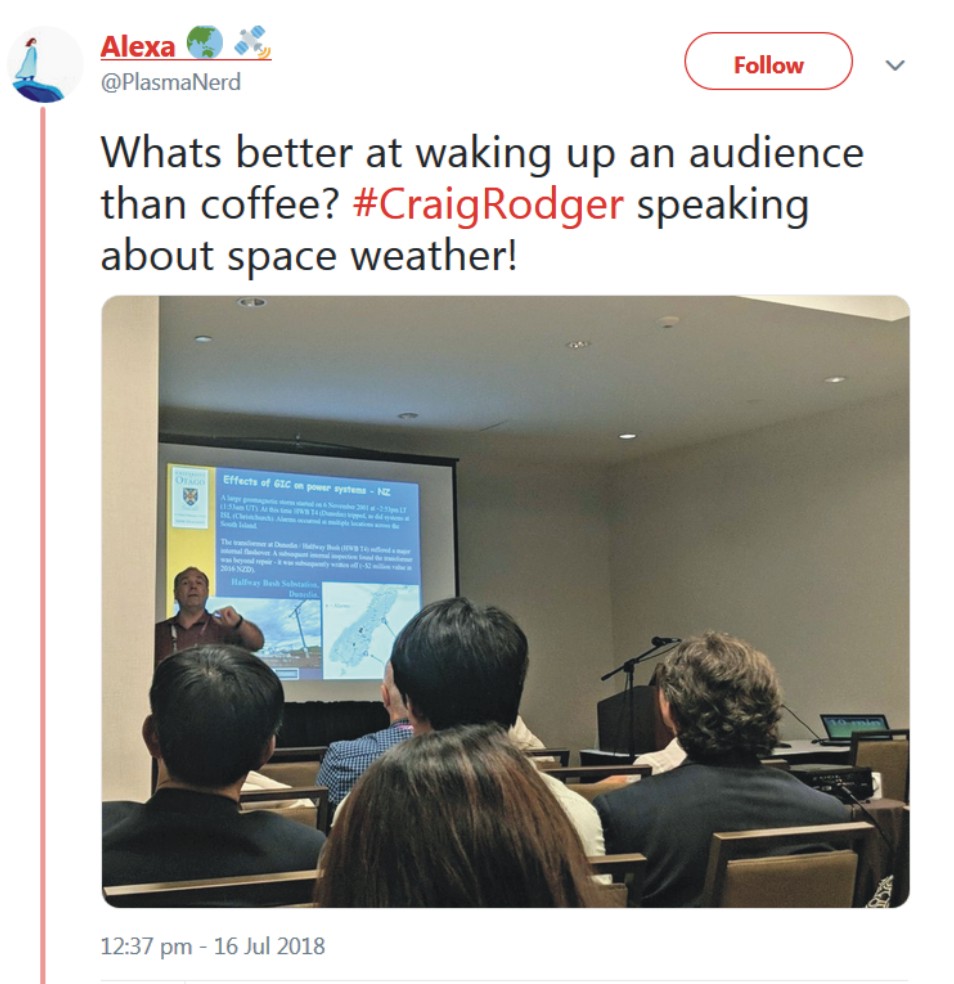
Tweet apparently sent midway through Craig’s COSPAR Space Weather presentation.
Expedition 10 home safe
On Saturday night the Otago Space Physics Group’s tenth annual Antarctic expedition return to Christchurch from Antarctica. They had not had a long time on the ice, heading south on the Sunday beforehand. Clearly, they worked hard! Space Physics Expedition Ten was made up of Dr. Tim Divett, and Dr James Brundell. It was Tim’s first trip to the ice, and James’ ninth. The C-17 they travelling home on was very full of cargo at the end of the summer season, and it was unclear if it would carry passengers. Thankfully a few people were squeezed in, so Tim and James got back to New Zealand not long after they have finished their primary tasks. Certainly an efficient trip [11 February 2018]
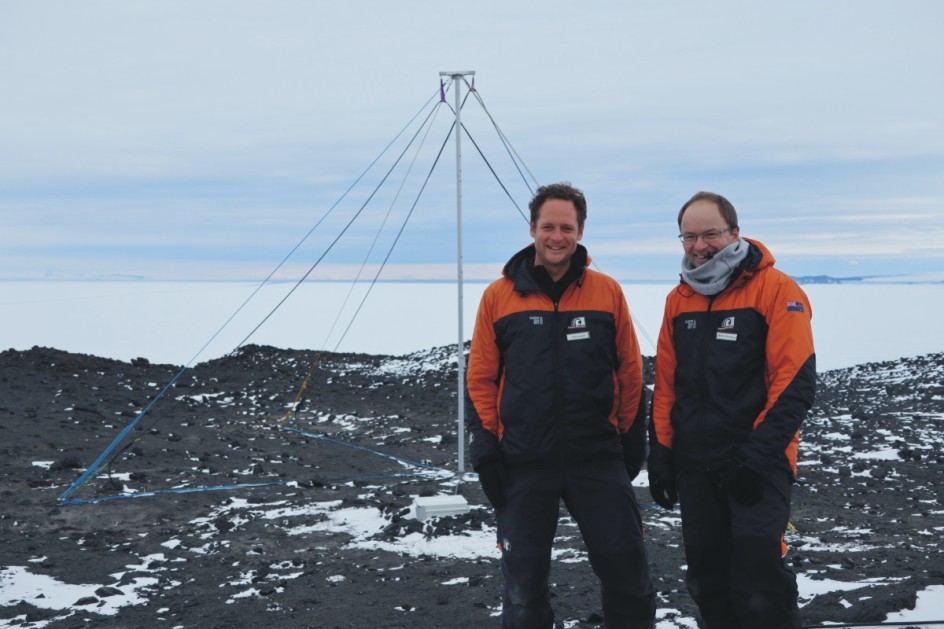
Tim and James at the Arrival Heights AARDDVARK antenna
Expedition 10 heading to the Antarctic
This morning the Otago Space Physics Group’s tenth annual Antarctic expedition departed Christchurch for Antarctica. Shortly before take off, Dr. Tim Divett sent us a photo from inside the USAF C-17 transport. Space Physics Expedition Ten is made up of Tim, and Dr James Brundell. This is Tim’s first trip to the ice, and James’ ninth. We are particularly pleased to hear they are heading away – due to some mechanical problems Tim and James have been “trapped in Christchurch” through a series of a one day delays.
The logistics support, comprising air transport, accommodation, and all other on-ice support is provided through Antarctica New Zealand Event K060. Tim and James will be based at Scott Base, and will work around the base and also up at Arrival Heights. Expedition 10 will gather high resolution data, undertake calibrations and replace the ropes supporting the mast of our Arrival Heights magnetic field loops – those ropes were originally installed in Expedition 1 in late 2008, and are showing signs of wear [4 February 2018].
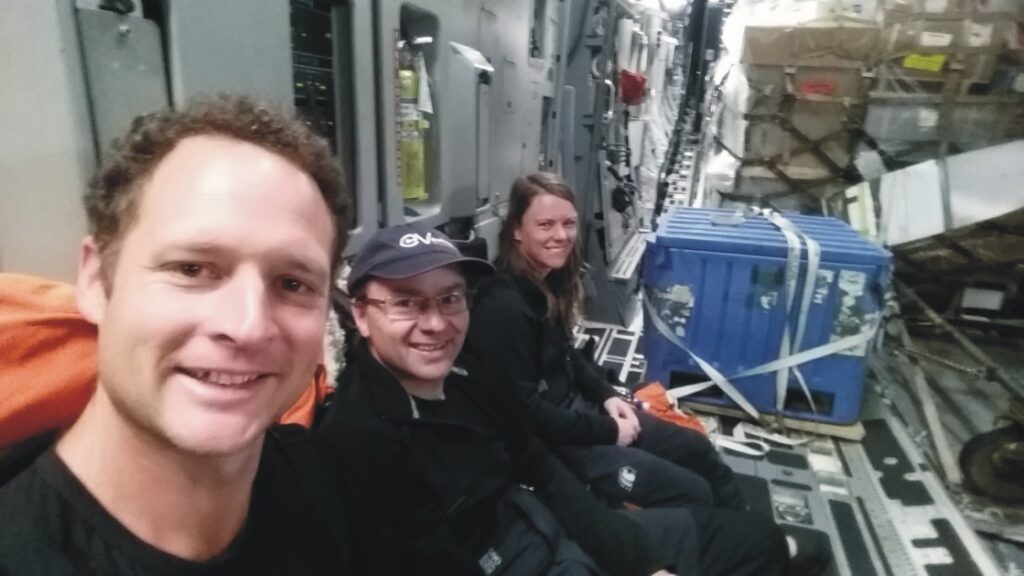
Not long before takeoff!
Aaron Hendry completes his PhD
Back in early October 2017 Aaron submited his PhD thesis for examination. Today that process came to an end – examiners reports arrived, some small revisions were required, and the changes were accepted. On 8 January 2018 Aaron took the final hardbound thesis over to Registry to hand them over. The examination processes has ended, and we have had confirmation that his thesis had been accepted. His thesis was entitled “Experimental evidence and properties of EMIC wave driven electron precipitation”. Aaron cannot use the”Dr” title until he has graduated, but he clearly has won this recognition, except for that formality. Congratulations Aaron! [8 January 2018].
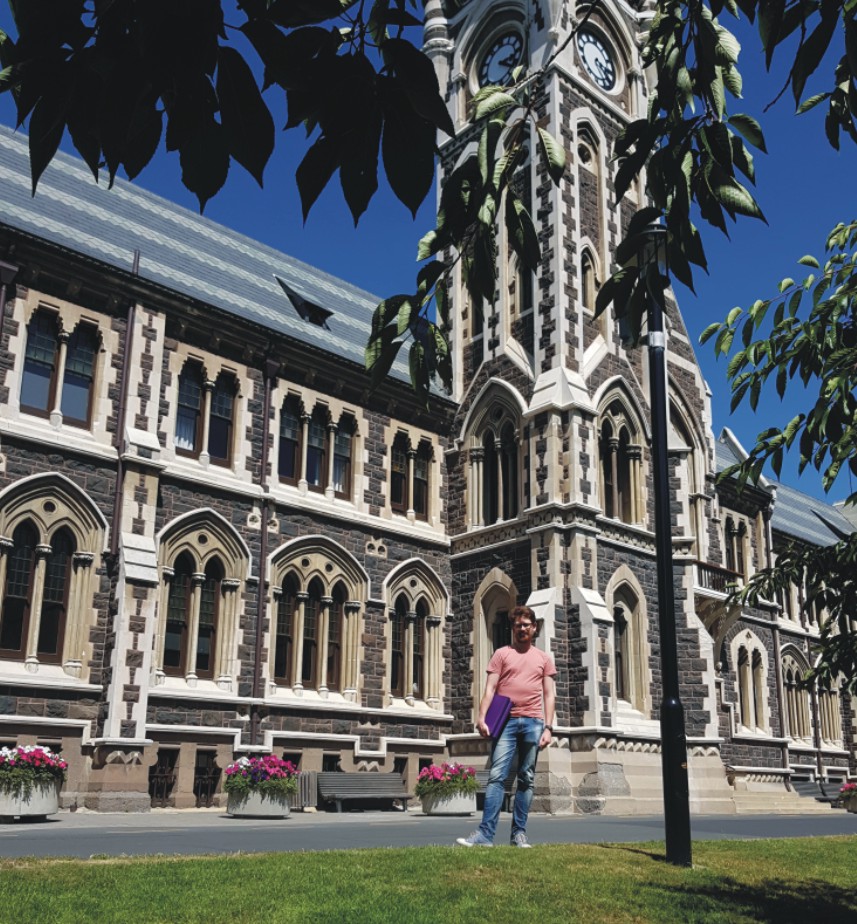
Aaron in front of the University of Otago clocktower, about to enter to hand in the thesis documents he is holding.
For newer or older news, look at the drop down Space Physics News Listing!